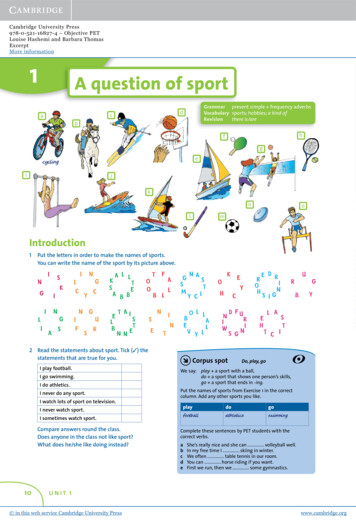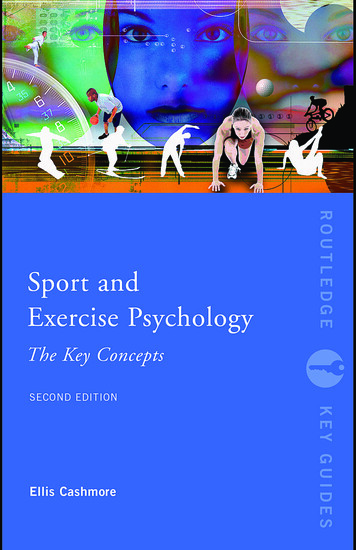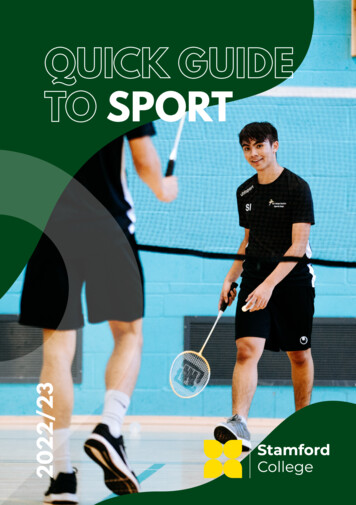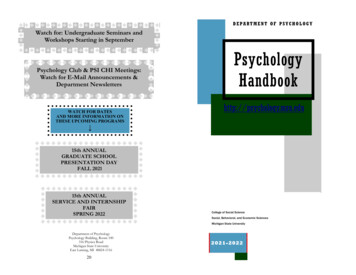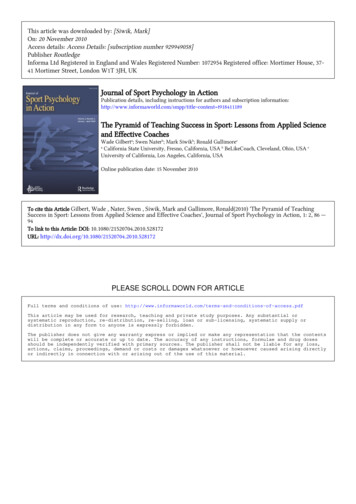
Transcription
This article was downloaded by: [Siwik, Mark]On: 20 November 2010Access details: Access Details: [subscription number 929949058]Publisher RoutledgeInforma Ltd Registered in England and Wales Registered Number: 1072954 Registered office: Mortimer House, 3741 Mortimer Street, London W1T 3JH, UKJournal of Sport Psychology in ActionPublication details, including instructions for authors and subscription information:http://www.informaworld.com/smpp/title content t918411189The Pyramid of Teaching Success in Sport: Lessons from Applied Scienceand Effective CoachesWade Gilberta; Swen Naterb; Mark Siwikb; Ronald GallimorecaCalifornia State University, Fresno, California, USA b BeLikeCoach, Cleveland, Ohio, USA cUniversity of California, Los Angeles, California, USAOnline publication date: 15 November 2010To cite this Article Gilbert, Wade , Nater, Swen , Siwik, Mark and Gallimore, Ronald(2010) 'The Pyramid of TeachingSuccess in Sport: Lessons from Applied Science and Effective Coaches', Journal of Sport Psychology in Action, 1: 2, 86 —94To link to this Article: DOI: 10.1080/21520704.2010.528172URL: SE SCROLL DOWN FOR ARTICLEFull terms and conditions of use: f-access.pdfThis article may be used for research, teaching and private study purposes. Any substantial orsystematic reproduction, re-distribution, re-selling, loan or sub-licensing, systematic supply ordistribution in any form to anyone is expressly forbidden.The publisher does not give any warranty express or implied or make any representation that the contentswill be complete or accurate or up to date. The accuracy of any instructions, formulae and drug dosesshould be independently verified with primary sources. The publisher shall not be liable for any loss,actions, claims, proceedings, demand or costs or damages whatsoever or howsoever caused arising directlyor indirectly in connection with or arising out of the use of this material.
Journal of Sport Psychology in Action, 1:86–94, 2010Copyright Association for Applied Sport PsychologyISSN: 2152-0704 print / 2152-0712 onlineDOI: 10.1080/21520704.2010.528172The Pyramid of Teaching Success in Sport:Lessons from Applied Scienceand Effective CoachesWADE GILBERTCalifornia State University, Fresno, California, USASWEN NATER and MARK SIWIKDownloaded By: [Siwik, Mark] At: 19:21 20 November 2010BeLikeCoach, Cleveland, Ohio, USARONALD GALLIMOREUniversity of California, Los Angeles, California, USAThe purpose of this article is to offer a tool both for identifyingthe qualities of effective coaches and for facilitating the professional development of youth sport coaches. We have labeled thistool the Pyramid of Teaching Success in Sport (PofTSS) to reflectthe widely held position that effective coaching is dependent uponteaching success. The PofTSS draws on multiple sources: (a) theauthors’ experiences across diverse careers in sport psychology, educational psychology, collegiate and professional sport, coaching,business performance and occupational stress, (b) four decades ofcoaching research, and (c) first-hand experience studying, playingfor, and working with legendary sport coach John Wooden. ThePofTSS, which includes 15 blocks and 10 pieces of mortar, focusescoaches on improvement of their teaching skills. This emphasis onself-improvement rather than measuring oneself against the performances of others is consistent with current views on how best todevelop human potential across domains.KEYWORDScoach development, youth sport, coachingCoaching effectiveness is a complex mix of art and science. This complexity is captured in hundreds of studies on sports coaching (Gilbert &Address correspondence to Wade Gilbert, California State University, Fresno, Department of Kinesiology, 5275 N. Campus Drive, M/S SG28, Fresno, CA 93740. E-mail:wgilbert@csufresno.edu86
Downloaded By: [Siwik, Mark] At: 19:21 20 November 2010Teaching Success in Sport87Trudel, 2004), and countless media reports, biographies, and autobiographies. This literature suggests some degree of consensus regarding potentialcontributions to youth development. Effective sport coaching helps youth realize greater satisfaction, higher self-esteem and improved relationships withcoaches and teammates while lowering performance anxiety and overalldropout rates (Smith & Smoll, 2002, 2007). These positive youth development outcomes have recently been re-organized into the 4 C’s of athletedevelopment—competence, confidence, connection, and character (Côté &Gilbert, 2009). Historically there has been less consensus on how to defineeffective sport coaching, particularly in youth sport settings. Many differentlabels have been used to describe quality coaching, including successful,model, elite, expert, winning, championship, and effective. A careful examination of this diverse literature, literal definitions of coaching, and researchdefinitions of effective coaching (Côté & Gilbert, 2009; Horn, 2008) show acommon theme—effective coaches are good teachers. It is from this perspective that we offer a tool both for identifying the qualities of effective coachesand for facilitating the professional development of youth sport coaches. Wehave labeled this tool the Pyramid of Teaching Success in Sport (PofTSS) toreflect the position that effective coaching is dependent upon teaching success. ‘Teaching Success’ is used instead of ‘Coaching Success’ also becausewe believe—like others before us—that all stakeholders in youth sport settings (e.g., officials, administrators, parents, peers) can and should play a rolein teaching athlete developmental outcomes (Gould & Carson, 2008; Smoll &Smith, 2002). Our goal, then, is to provide a way for coaches—and those whowork with coaches—to summarize available evidence on effective coachingand represent that evidence in a form useful for professional development.Careful reflection on one’s practice is critical to becoming an effective coach(Côté & Gilbert, 2009; Nater & Gallimore, 2010). The PoTSS provides a toolto stimulate and direct coaches’ reflection, thereby empowering them to takecontrol of their ability to improve their teaching effectiveness.A REPRESENTATION OF EFFECTIVE COACHING: THE PYRAMIDOF TEACHING SUCCESS IN SPORTThe Pyramid of Teaching Success in Sport (PofTSS) was partially inspiredby Coach Wooden’s Pyramid of Success and his lifelong dedication to improving the quality of teaching (Nater & Gallimore, 2010; The Official Siteof Coach John Wooden, n.d.; Wooden, 2004). Coach Wooden’s Pyramidof Success was originally created to help his high school English studentshave the peace of mind to feel successful if they made the effort to become the best they could be. Wooden’s Pyramid consists of 15 blocks ofdesirable learning outcomes, each of which is a means and a precursor ofsubsequent athletic and academic development. Coach Wooden’s timelessapproach to teaching which is captured in the Pyramid continues to inform
Downloaded By: [Siwik, Mark] At: 19:21 20 November 201088W. Gilbert et al.guidelines for developing a sound coaching philosophy (Burton & Raedeke,2009; Hammermeister, 2010; Vealey, 2005) and scientific investigations ofteaching and its improvement (Gallimore & Tharp, 2004; Nater & Gallimore,2010).Arguably, Wooden’s Pyramid of Success reflects in a compelling graphicthe four essential dimensions of athlete development: competence, confidence, connection, and character (Côté & Gilbert, 2009). While Wooden’sPyramid expresses athlete developmental outcomes, it neither defines fora coach how to improve teaching and learning nor identifies the buildingblocks of effective coaching. We have crafted the PofTSS as a potential toolfor addressing this gap. In its current form the PofTSS is the result of severalyears of careful deliberation based on insights gleaned from multiple sources:(a) the authors’ experiences across diverse careers in sport psychology, educational psychology, collegiate and professional sport, coaching, businessperformance and occupational stress, (b) four decades of coaching researchnow summarized in articles and an ever-growing list of books (e.g., Cassidy,Jones, & Potrac, 2009; Horn, 2008; Jowett & Lavalle, 2007; Lyle & Cushion,2010), and (c) first-hand experience studying, playing for, and working withlegendary coach John Wooden.In March 2010 at the annual convention of the American Alliance forHealth, Physical Education, Recreation and Dance, the PofTSS was successfully introduced to a large audience of coaches, administrators and sportscientists. The response of this group to the PofTSS inspired us to write thisarticle as a way to foster additional discussion about the elements of effectivecoaching, and solicit feedback from a wider audience.THE PYRAMID OF TEACHING SUCCESS IN SPORT (PofTSS)The Pyramid of Teaching Success in Sport (see Figure 1) is composed offive tiers. The rows of blocks and mortar are hierarchically arranged torepresent qualities we have found to be indispensable to successful teachingin sport. Each row is foundational to the next. The first tier comprises qualitiesrequired in any human endeavor that seeks to nurture the developmentand performance of others—coaching, parenting, teaching, and leading toname a few. The second tier includes four qualities required to sustaincontinuous improvement personally, and in a community of learning withothers also committed to the development of capable, confident, connectedand character-based youth. The third tier includes knowledge about teachingand the content and skills to be taught; and critically, the multiple forms ofcondition required of a teacher—moral, mental, emotional, and physical. Wecannot teach what we do not know; we cannot teach what we know if wecannot make it comprehensible to learners; and we cannot teach effectivelywithout the conditioning that strenuous demands of teaching require.
Downloaded By: [Siwik, Mark] At: 19:21 20 November 2010Teaching Success in Sport89FIGURE 1 The Pyramid of Teaching Success in Sport.C (graphic and contents) is copyrightedNote: The Pyramid of Teaching Success in Sport and owned by BeLikeCoach, Inc. (BeLikeCoach.com) and is free for public use, copying, anddistribution by individuals and organizations dedicated to improving learning, teaching, sport,and youth development.The fourth and fifth tiers include three qualities resting on the 3 levelsand 12 personal qualities that support it in the Pyramid. Commitment to thevalues and principles represented in the Pyramid keep an effective coachgrounded and clear about the purposes of teaching. Commitment gives thecoach the courage of conviction to adhere to those values when pressuresbuild to relax standards and compromise principles. Finally, the apex (thefifth tier) of the Pyramid is the recognition that simply conducting a practice isnot successful teaching in sport. We offer the following definition of teachingsuccess in sport that we believe captures these qualities presented in thePyramid:Peace of mind which is a direct result of self-satisfaction in knowing thatyou have made the effort to ensure that all those under your supervisionlearn how to reach their potential in sport and beyond.The First Tier—The Foundation of Teaching SuccessThe first tier of the PofTSS contains five blocks, two of which are cornerstonesthat stabilize the structure. The cornerstones are two timeless and universal
90W. Gilbert et al.principles. Love in the context of teaching sport, we define as the selflessaltruistic and unconditional dedication to help each athlete succeed at alltimes. Balance means the practice of moderation and perspective in all thingsand maintaining an alignment between what the coach thinks, says, anddoes. Between the cornerstones are the blocks of Friendship, Loyalty, andCooperation. Regular practice of friendship, loyalty and cooperation sets thestage for collaboration and the opportunity to learn from others. Dependingon others for what one needs to learn requires building strong relationships,being loyal to the needs of others and sharing what you know.Downloaded By: [Siwik, Mark] At: 19:21 20 November 2010The Second Tier—The Coach’s Learning CommunityEffective coaches understand that they cannot improve by themselves. Learning how to coach effectively is facilitated by participating in informal andformal communities of learning with coaching peers (Gilbert, Gallimore, &Trudel, 2009). Collaborative coaches view competition as an opportunity togrow and improve in the common pursuit of athletic excellence and development of human potential. Just as a well-played game requires twowell prepared teams, effective collaboration requires preparation and selfstudy. The elements of collaboration, individual preparation and inquiry, areexpressed by the four blocks making up the second tier of the Pyramid:Industriousness, Curiosity, Resourcefulness, and Self-examination. Industriousness is hard work based on careful planning. Curiosity is the deep desireto know why, not just how, and it is the pathway to deeper knowledge.Resourcefulness is needed to overcome challenges to ongoing learning. Selfexamination spurs future growth by eliminating weaker ideas and ineffectivepractices, setting new goals to pursue, and aligning everyday behavior withcore values, especially love and balance.The Third Tier—The Heart of the PyramidThe third tier is the heart of the Pyramid because it focuses on the core elements of effective teaching in sport: Pedagogical Knowledge, Subject Knowledge and Conditioning. Pedagogical Knowledge is knowing how to makecontent comprehensible and accessible to athletes, and how to structureactivities that optimize the development and mastery of sport skills. It isknowing and understanding that effective instruction depends on the ageand development of the athlete—what might work for teenagers will notnecessarily work for younger children (Côté & Gilbert, 2009). Knowing thatplayers might learn more if first introduced to the whole concept and entire body of actions, than if they begin practicing small bits is a form ofPedagogical Knowledge.Subject Knowledge is knowing the content to be taught, whether it isrules of the game or fielding at first base. Effective coaches continue to
Downloaded By: [Siwik, Mark] At: 19:21 20 November 2010Teaching Success in Sport91study and learn the sport they teach so they are better able to instruct inage-appropriate ways and to help athletes develop the same habits of selfstudy and continuous learning the coaches themselves practice. An athlete’sintrinsic motivation to grow and excel are nurtured by coaches that set theexample of working continuously to better understand the fundamentals ofall four dimensions of athlete development: competence, confidence, connections, and character.Conditioning for the sport coach is no different than conditioning forthe athlete—it takes physical, mental, emotional, social and moral enduranceto be at your best for not just a single practice or game, but an entire season.We cannot teach effectively without the conditioning that the strenuousdemands of teaching sport require. Ultimately, coaches are role models whoteach more by their actions than their words. This concept is best expressedthrough an anonymous poem that Coach Wooden used to express his beliefabout the role of conditioning for teachers in setting an example for theirlearners:No written word, no spoken pleaCan teach our youth what they should beNor all the books on all the shelvesIt’s what the teachers are themselves.The Fourth Tier—Courage and CommitmentThroughout their careers, coaches and teachers confront pressure to relaxstandards and let students and players slide by. Every coach knows thechallenges youth can present–settling for “good enough” instead of strivingto improve, failing to meet responsibilities to self and teammates, and amyriad other situations which puts values and principles to the test. Valuecommitments provide the courage of convictions that every coach needs todefend principles and maintain standards. They know what they believe andthat provides the courage to stand up to parents, program directors, andother authority figures who are prepared to honor expediency over welfareand development of youth. The two blocks of the fourth tier, Courage andCommitment, describe these coaches. They have the courage to fight forwhat they believe in and a loyal commitment to helping each athlete reachhis or her full potential.The Apex—TeacherThe ultimate measure of effective sport coaching is whether the athletes havelearned what we have aspired to teach them (Côté & Gilbert, 2009). If a coachcan say that he or she has done everything possible to help an athlete learn,
92W. Gilbert et al.that coach will have reached the apex of the Pyramid which is Teacher. Likethe Courage and Commitment blocks, Teacher is not something you workon but rather it is a perpetual state of becoming that flows from working onthe 12 blocks in the first three tiers. Two of our favorite Wooden maxims are“when you are through learning, you’re through” and that “it’s what you learnafter you know it all that counts” (Nater & Gallimore, 2010; Wooden, 2004).These maxims recognize that there are constant gaps in ongoing learningand to fill these gaps, we have selected ten qualities expressed as mortar inthe Pyramid.Downloaded By: [Siwik, Mark] At: 19:21 20 November 2010MortarMuch like mortar is used to bind construction blocks together to producea hardier structure, our mortar is intended to produce a stronger and morecapable sport coach. Ten qualities expressed as mortar are proposed as reinforcements of the Pyramid. Connecting and binding the first tier (foundationof effective teaching) to the second tier (self-study and collaboration) areEmpathy and Honesty. Empathy is the ability to recognize and consider thethoughts, feelings and emotions of others and Honesty is the ability to staytrue to what is best in ourselves and others. Initiative and Preparation ensurethat the sport coach will engage in self-study and seek out others to learnwith and from and as such they bridge the gap between the coach’s learningcommunity and the three essential elements to effective teaching: communication skill, deep knowledge and conditioning. Anticipation of athlete needsand learning styles and Consistency in word and action help the sport coachdevelop the qualities of Courage and Commitment. These qualities, in turn,are sustained by the Patience in knowing that good things take time andExperience that comes from sustained thinking and problem-solving. At theapex of Teacher, we place Wisdom and Judgment. Ultimately, teachers andcoaches are role models who teach more by their actions than their words(Gould, Collins, Lauer, & Chung, 2007).SUMMARYWe present the PofTSS as a platform for stimulating further discussion andreflection about effective coaching in youth sport. The Pyramid identifiesthe personal qualities and values we have found to be important in helpingothers reach their potential through sport. Both our definition of teaching success and the qualities represented in the Pyramid emphasize selfimprovement rather than measuring oneself against the performances ofothers. This is consistent with current views on how best to develop humanpotential. For example, in the achievement motivation literature this internalfocus on personal development is referred to as a task- or mastery-orientation
Teaching Success in Sport93(Harwood, Spray, & Keegan, 2008). In the developmental psychology literature this orientation is sometimes labeled a growth mindset (Dweck, 2007).Lastly, this approach firmly situates coaching as a moral profession. Effectivecoaches understand that no matter how long one teaches and no matter howmany courses and books are consumed, challenges arise for which knowledge and experience alone are insufficient preparation. In these moments,an ethical and moral grounding provides a platform to do what is right for theathlete (Gould et al., 2007). The Pyramid will surely evolve as we continueto share and test the ideas it represents. We look forward to hearing yourthoughts about the Pyramid and how it fits with your experiences coachingand working in youth sport settings.Downloaded By: [Siwik, Mark] At: 19:21 20 November 2010ACKNOWLEDGEMENTSThe authors gratefully acknowledge the respective contributions of CoachJohn Wooden, Doug Saylor, Jerry Krause and Eva Dolan to the developmentof this article. Appreciation to Karen Becker for graphic design of the Pyramidof Teaching Success in Sport.REFERENCESBurton, D., & Raedeke, T. D. (2009). Sport psychology for coaches. Champaign, IL:Human Kinetics.Cassidy, T., Jones, R. L., & Potrac, P. (2009). Understanding sports coaching: Thesocial, cultural and pedagogical foundations of coaching practice (2nd ed.).London, UK: Routledge.Côté, J., & Gilbert, W. D. (2009). An integrative definition of coaching effectivenessand expertise. International Journal of Sports Science & Coaching, 4, 307–323.Dweck, C. S. (2007). Mindset: The new psychology of success. New York, NY:Ballantine.Gallimore, R., & Tharp, R. (2004). What a coach can teach a teacher, 1975–2004:Reflections and reanalysis of John Wooden’s teaching practice. The Sport Psychologist, 18, 119–137.Gilbert, W., Gallimore, R., & Trudel, P. (2009). A learning community approach tocoach development in youth sport. Journal of Coaching Education, 2(2), 1–21.Gilbert, W. D., & Trudel, P. (2004). Analysis of coaching science research publishedfrom 1970–2001. Research Quarterly for Exercise and Sport, 75, 388–399.Gould, D., & Carson, S. (2008). Life skills development through sport: Current statusand future directions. International Review of Sport and Exercise Psychology,1(1), 58–78.Gould, D., Collins, K., Lauer, L., & Chung, Y. (2007). Coaching life skills throughfootball: A study of award winning high school football coaches. Journal ofApplied Sport Psychology, 19, 16–37.
Downloaded By: [Siwik, Mark] At: 19:21 20 November 201094W. Gilbert et al.Hammermeister, J. J. (2010). Cornerstones of coaching: The building blocks of successfor sport coaches and teams. Traverse City, MO: Cooper.Harwood, C., Spray, C. M., & Keegan, R. (2008). Achievement goal theories insport. In T. S. Horn (ed.), Advances in sport psychology (3rd ed., pp. 157–185).Champaign, IL: Human Kinetics.Horn, T. (Ed.). (2008). Advances in sport psychology (3rd ed.). Champaign, IL: HumanKinetics.Jowett, S., & Lavallee, D. (Eds.). (2007). Social psychology in sport. Champaign, IL:Human Kinetics.Lyle, J., & Cushion, C. (Eds.). (2010). Sports coaching: Professionalisation and practice. Oxford, UK: Elsevier.Nater, S., & Gallimore, R. (2010). You haven’t taught until they have learned: JohnWooden’s teaching principles and practices. Morgantown, WV: Fitness International Technology.Smith, R. E., & Smoll, F. L. (2002). Way to go coach! (2nd ed.). Portola Valley, CA:Warde.Smith, R. E., & Smoll, F. L. (2007). Social-cognitive approach to coaching behaviors. In S. Jowett & D. Lavallee (Eds.), Social psychology in sport (pp. 75–90).Champaign, IL: Human Kinetics.Smoll, F. L., & Smith, R. E. (Eds.). (2002). Children and youth in sport: A biopsychosocial perspective (2nd ed.). Dubuque, IA: Kendall/Hunt.The Official Site of Coach John Wooden. (n.d.). Retrieved from http://www.coachwooden.com/Vealey, R. (2005). Coaching for the inner edge. Morgantown, WV: Fitness Info Technology.Wooden, J. R. (2004). My personal best: Life lessons from an All-American journey(with Steve Jamison). New York, NY: McGraw-Hill.
The Pyramid of Teaching Success in Sport (PofTSS) was partially inspired by Coach Wooden's Pyramid of Success and his lifelong dedication to im-proving the quality of teaching (Nater & Gallimore, 2010; The Official Site of Coach John Wooden, n.d.; Wooden, 2004). Coach Wooden's Pyramid of Success was originally created to help his high .

